Friday, March 30, 2018
Lush Greenery Pictures Beautiful Gardens WonderWordz
Thursday, March 29, 2018
Garden View EveryAptMapped New Brighton, MN Apartments
File:Public Garden view.jpg Wikimedia Commons

Garden View Guest Room The RitzCarlton, Grand Cayman

Another garden view Picture of Fern Cottage Tour, Ferndale TripAdvisor
Another garden view Picture of Fern Cottage Tour, Ferndale TripAdvisor
Wednesday, March 28, 2018
Garden View Guest Room The RitzCarlton, Grand Cayman
 A garden is an organized space, usually outdoors, reserve for the display, nurturing and enjoyment of crops and other varieties of characteristics. Your garden can include both natural and man-made materials. The most frequent form today is known as a residential garden, but the term garden has typically been a much more general one. Zoos, which display outrageous animals in simulated natural habitats, were formerly called zoological gardens.[1][2] Western gardens are almost universally based upon crops, with garden often symbols of a shortened form of botanical garden. Some traditional types of eastern home gardens, such as Zen home gardens, use plants sparsely or not at all.
A garden is an organized space, usually outdoors, reserve for the display, nurturing and enjoyment of crops and other varieties of characteristics. Your garden can include both natural and man-made materials. The most frequent form today is known as a residential garden, but the term garden has typically been a much more general one. Zoos, which display outrageous animals in simulated natural habitats, were formerly called zoological gardens.[1][2] Western gardens are almost universally based upon crops, with garden often symbols of a shortened form of botanical garden. Some traditional types of eastern home gardens, such as Zen home gardens, use plants sparsely or not at all.Garden View Tea Room
Guest Review: Afternoon Tea at the Grand Floridian\u2019s Garden View Lounge the disney
Window View Glimpse Of Tranquility Japanese Garden Painting by Elaine Plesser

HotelR Best Hotel Deal Site
Monday, March 26, 2018
Best Activity Cube For Toddlers
Maxim Enterprise EverEarth Garden Activity Cube by OJ Commerce 33285 $82.09
Little Tikes Kids Activity Garden, Childrens Play Centre
30 Garden \u0026 Plant Activities for kids Edventures with Kids
Light\u2019n Go activity Garden Treehouse \u2013 Little Tikes MGA Entertainment Jouet de
Sunday, March 25, 2018
Lush Greenery Pictures Beautiful Gardens WonderWordz
Beautiful leaf gardens garden design
28 Beautiful Gardens Like Dream MostBeautifulThings
Pictures Of Beautiful Garden Landscapes [peenmedia.com]
Beautiful English Garden
Saturday, March 24, 2018
Garden View Villas in Koh Samui SamuiIslandVillas.com
File:Carolnads, Western Garden view from Bordeaux Room 2013.jpg Wikimedia Commons

HotelR Best Hotel Deal Site
Accommodation Kuiburi Hotel \u0026 Resort

HotelR Best Hotel Deal Site
Another garden view Picture of Fern Cottage Tour, Ferndale TripAdvisor
By admin3:46 AMAnother, Cottage, Fern, Ferndale, garden, Picture, Tour, TripAdvisor, view
No comments:

Country Landcapes Ltd Table of Contents Page
Window View Of Garden www.imgkid.com The Image Kid Has It!
File:View from Peacock Garden in Warwick Castle.jpg Wikimedia Commons

Mykonos Rooms Romantic Sea View in Mykonos Island Greece
Thursday, March 22, 2018
Fun Garden Activities For Kids Children\u2019S Garden Activity Ideas Garden Fall home
 A garden is an organized space, usually outdoors, reserve for the display, nurturing and enjoyment of vegetation and other kinds of characteristics. Your garden can include both natural and man-made materials. The most typical form today is known as a residential garden, but the term garden has typically been an even more general one. Zoos, which display outrageous animals in simulated natural habitats, were formerly called zoological gardens.[1][2] Western gardens are almost universally based upon vegetation, with garden often symbols of a shortened form of botanical garden. Some traditional types of eastern backyards, such as Zen home gardens, use plants sparsely or not at all.
A garden is an organized space, usually outdoors, reserve for the display, nurturing and enjoyment of vegetation and other kinds of characteristics. Your garden can include both natural and man-made materials. The most typical form today is known as a residential garden, but the term garden has typically been an even more general one. Zoos, which display outrageous animals in simulated natural habitats, were formerly called zoological gardens.[1][2] Western gardens are almost universally based upon vegetation, with garden often symbols of a shortened form of botanical garden. Some traditional types of eastern backyards, such as Zen home gardens, use plants sparsely or not at all.Little Tikes Garden Activity Center Hot Girls Wallpaper
Light\u2019n Go activity Garden Treehouse \u2013 Little Tikes MGA Entertainment Jouet de
Little Tikes Activity Garden Walmart.com

Fun Garden Activities For Kids Children\u2019S Garden Activity Ideas Garden Fall home

Accommodation Kuiburi Hotel \u0026 Resort
 A garden is a designed space, usually outdoors, schedule for the display, fostering and enjoyment of plant life and other varieties of mother nature. Your garden can include both natural and man-made materials. The most typical form today is known as a residential garden, but the term garden has customarily been a much more general one. Zoos, which display outrageous animals in simulated natural habitats, were formerly called zoological gardens.[1][2] Western gardens are almost universally based upon vegetation, with garden often symbols of a shortened form of botanical garden. Some traditional types of eastern home gardens, such as Zen backyards, use plants sparsely or not at all.
A garden is a designed space, usually outdoors, schedule for the display, fostering and enjoyment of plant life and other varieties of mother nature. Your garden can include both natural and man-made materials. The most typical form today is known as a residential garden, but the term garden has customarily been a much more general one. Zoos, which display outrageous animals in simulated natural habitats, were formerly called zoological gardens.[1][2] Western gardens are almost universally based upon vegetation, with garden often symbols of a shortened form of botanical garden. Some traditional types of eastern home gardens, such as Zen backyards, use plants sparsely or not at all.Joe Wainwright Garden Photographer\u002639;s Association

Bohemian Trails \u00bb Travel Tips for the AvantGarde \u00bb Gardens, Goats and Great Views
File:South Carolina Botanical Garden view 2.JPG Wikipedia
HotelR Best Hotel Deal Site
Wednesday, March 21, 2018
Welcome To My Garden More Thyme Than Dough
view garden Picture of Mas d\u002639;Oleandre, MontarenetSaintMediers TripAdvisor

Open window
Accommodation Airlie Beach Coral Sea Resort

Accommodation Airlie Beach Coral Sea Resort






